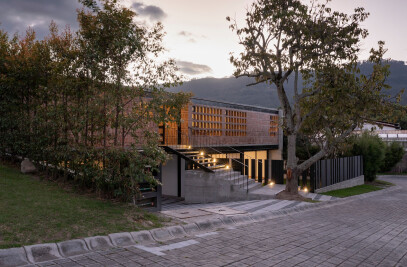The project is established from the request of three American friends who lived in their early ages in Ecuador and wanted a place where they can reunite and reconnect with the country.
It is located in Pijal, a community of mainly Otavaleña indigenous population, on the slopes of San Pablo Lake, one the most important lakes in Ecuador. From the site, the North Ecuadorian Andes can be easily seen such as Cusín Hill, in the front; the great Imbabura Volcano; and the Cotacahi Volcano a little bit further north.

As the topography of the lot descends contrary to the Lake, the architectural piece embeds in the opposite direction to the slope, obtaining visuals of the Lake and the extensive landscape of the northern Ecuador. This design decision imposes half of the volume to be buried in the ground, and the other half to rise an epic 12m long cantilever, perpendicular to the level curves.
The large cantilever determined the resolution of the project in terms of the structural system. The structure is composed of two large parts: one made of heavy concrete anchored to the ground, from which an habitable cantilevered steel beam is attached.

The architectural volume contains the entire program; the access is located under the cantilever along with a vertical circulation. This element connects the two floors and is placedin the center of the floor plan to solve the public and private zoning of the project.
The private area has three equally sized bedrooms with two full bathrooms at each end. The rooms belong to everyone, a large closet divided into three parts was proposed to ensure that each one of the owners have their own. Therefore, everyone can use any room that is available at the moment.

All the living spaces are oriented towards San PabloLake, the bedrooms have direct access through sliding glass doors to the garden, which is located at the upper part of the land. The common area, already elevated from the ground, is glazed on all three fronts, having as a result a total integration of this Andean landscape.
The constructive essence is manifested in the finishes such as the thick concrete walls. These were carefully formworked with plywood boards and subtly appear in different parts of the house. Likewise, the metallic elements as beams, columns, and diagonals, are part of the carpentry, allowing lightness and transparencies to incorporate the landscape into the interior. The floors are made of polished and sealed concrete slabs, and pine staves are used in doors, furniture and in the suspendedceiling which liesabove the social areas, giving warmth to the interior by contrasting with the exposed concrete.

Implementing this super structure in the rural landscape of the Ecuadorian Andes meant a massive constructive feat, where we faced very complex challengessuch as the difficult access due to muddy trails because of the long rainy season. Moreover, the socialization of such a radical structure with the community, access to basic services or the provision of materials.

The spectacular nature of the project is undeniable. A work of rigorous construction that stands out defiantly on the hillside to be seen and admired like an inhabitable sculpture. The objective is not only to be notable from the Lake shores, but to also appreciate the beauty from its interior, that idyllic landscape of water and mountains.
Team:
Lead Architects: Arq.Bernardo Bustamante, Arq. Doménika Baquero, Arq. Nuria Vidal






























































